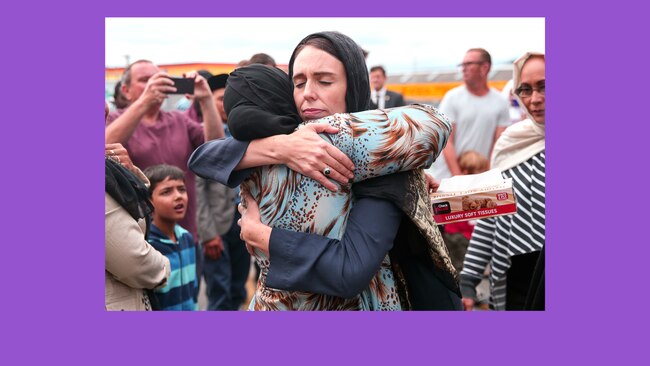If you're not empathising, are you really leading?
Often, when we’re seeing empathy, it’s actually sympathy. And there’s a time and a place for each.

Often, when we’re seeing empathy, it’s actually sympathy. And there’s a time and a place for each.
There’s no question that, along with female leaders such as German Chancellor Angela Merkel and Danish Prime Minister Mette Frederiksen, New Zealand Prime Minister Jacinda Ardern has helped transform empathy into a buzzword and, apparently, a sought-after style of leadership, especially in the workforce.
Ms Ardern literally inspired the book Leading With Empathy. During Covid, the world watched in awe as she kept her nation healthy and safe - and did so with what appeared to be total authenticity. Before that, moments such as the Christchurch massacre put her compassion on display as she appeared to share the suffering of those she comforted.
But often when we’re seeing empathy, it is actually sympathy. And there is a time and a place for each. If you understand the nuances of both, you are much more likely to tap into the correct trait at the correct time.
We are all supposed to be striving for empathy now, rather than settling for sympathy.
Author, academic and TED talk icon Brené Brown said, “empathy fuels connection, sympathy fuels disconnection”.
“In someone else’s shoes” ?
Clinical psychologist Danni McClellan explains “empathy isn’t just about understanding another’s perspective, it’s about imagining ourselves in the situation of another and sharing in their emotional experience”.
“Empathy isn’t about having the right response; it’s about connecting with the feelings of the other, by listening with openness, curiosity and compassion.”
Ms McClellan works with high school-aged children every day and says good emotional intelligence — which empathy plays a huge role in — cannot be underestimated when it comes to helping friends through tough times. She uses heartbreak as an example.
“When a friend calls you in tears because they’re going through a breakup, empathy is the process of putting ourselves in our friends’ shoes and viscerally connecting with the part of ourselves that knows what heartbreak feels like,” she says.
Ms McClellan adds that, often, people who have experienced hardship tend to have a greater capacity for empathy as they have a “background of emotional experiences to draw from”.
“Going through hard times builds your capacity to bounce back, but it also builds your ability to have empathy.”
On the other hand,“sympathy is typically associated with feelings of pity and concern for the misfortune of another,” Ms Mclellan says.
That doesn’t sound so bad?
Sympathy can actually be problematic as it means we “externalise” ourselves from the person we are encountering, and their experience.
“It creates disconnection, in that the act of feeling sorry for someone automatically ‘others’ that person from ourselves.”
Ms McClellan points out sympathy does have its place — the alternative would be apathy, which doesn’t really get anyone anywhere.
But, unlike empathy, which occurs when we put ourselves in someone else’s shoes, sympathy is expressed when we feel sorry for someone but can’t necessarily resonate with their experience. Because of this — and depending on your own emotional state, or the state of the person you’re helping — sympathy can arouse even more shame and self-consciousness.
A handy one to keep in mind the next time you go to say, “Aw, I feel so sorry for you!”
Empathy at work and play
Humans are hardwired to connect with one another. Our ability to build strong connections is key to living a happy, fulfilled life, both at home and in the workplace.
“Empathy and emotional intelligence were previously overlooked in the workplace but now they’re recognised as key components of a successful career and a mark of a good leader,” Ms McClellan notes.
“Research demonstrates that empathetic leaders who understand and are responsive to the needs of those they lead are viewed as more highly performing by their own bosses.”
Empathy will also help to deepen your personal relationships. “When we share our deepest fears and insecurities with a partner, and they respond with empathy and compassion, our sense of trust and safety is strengthened,” Ms McClellan says.
“In the therapy room, a large part of working with couples and families is about helping couples to express vulnerable feelings and respond with empathy.”
How do I ‘be more empathetic’?
Great question. Like most feeling-based responses, empathy is not necessarily something you can just switch on. The good news is that it is possible to practise showing greater empathy, but it starts with some deep inner work: becoming more accepting of your own emotions.
If this does not have you rushing to close your browser window or slam your laptop shut, then here’s a little exercise to get you started: Can you acknowledge strong feelings when they arise, rather than denying or minimising them? Can you pay attention to the physical sensations in your body, put a name to the feeling? Perhaps sadness, anger or shame?
If you can, you’re already on the road to being more empathetic.
“The more practised we are at noticing and acknowledging our own feelings, the more easily we are able to connect to the feelings of others,” Ms McClellan explains.
Next, it’s about what Ms McClellan calls “active listening”.
“It’s about listening to connect — not to correct, instruct or give feedback.”
In other words, leave your passive-aggressive stance at the door.
Some ways to practise active listening, and therefore generate a more empathetic response, are: Notice and name the emotions you observe in yourself, or the person you are helping. “Studies show that when we name our emotions, or have others name them for us, the emotion centre of the brain (the amygdala) calms itself, because we feel understood,” Ms McClellan says.
Next, repeat what the person has said, using your own words.
“What I’m hearing you say is…”, is a great way to show a person you are picking up what they are putting down. Ask open-ended questions and avoid asking “Why?”.
Finally, withhold judgment and resist the urge to give advice, unless the person you are consoling explicitly asks for it. Sometimes, we don’t need a therapy session. A shoulder to cry on is enough.
Are women more empathetic than men?
Studies confirm that, compared with men, women tend to have higher levels of empathy, emotional responsiveness and “mirroring responses to others’ pain,” Ms McClellan says.
Incredibly, even female babies have been shown to be better at empathising - which you see through contagious crying and social referencing (looking to others for social information) - compared with male babies.
Although this would suggest a fundamental biological difference in the way men and women express empathy, Ms McClellan is quick to point out the way women and men express (or don’t express) empathy is greatly influenced by cultural and social norms.
“Generally, society allows women to more freely express their vulnerable feelings, whereas conventional masculine stereotypes encourage men to conceal and disconnect from their own vulnerabilities.”
She says men feel empathy, but are not as practised at demonstrating it.
“Sadly, we know that the suicide rates among men are significantly higher than that of women, as men are less likely to express their vulnerable feelings and seek help.”
Thanks to the softening of patriarchal stereotypes and the work of men’s mental health charities such as Movember and Top Blokes Foundation, it is no longer taboo for men to be in touch with their emotions, and that includes the ability to give and receive empathy — something Ms McClellan claims young men are mastering. There are plenty of leaders who could take a leaf out of their book.
Danni McClellan is a registered clinical psychologist who currently works as a psychologist at Sydney school Wenona.



